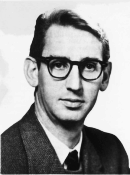Electronics Pioneers & History
- See Full List of AI Topics -

John Battiscombe Gunn, widely known as J.B. Gunn, was a British physicist and
electrical engineer whose groundbreaking research in semiconductors led to the discovery
of the Gunn effect and the invention of the Gunn diode, a pivotal device in microwave
technology. Born in 1928 in Croydon, England, Gunn spent his early childhood in
a modest but intellectually nurturing household. His father, a civil servant, and
his mother, a schoolteacher, both encouraged his academic curiosity. Although his
family was not wealthy, education was highly valued, and the atmosphere in his home
was one of learning and discipline. He grew up alongside two siblings, both of whom
went on to pursue academic careers of their own.
As a child, Gunn showed a marked interest in science, especially in the physical
sciences. He was known for his curiosity and keen analytical mind, frequently experimenting
with simple electrical devices at home. However, his health was not always robust.
In his early teens, he contracted a respiratory illness that led to extended absences
from school, but his parents ensured he stayed intellectually engaged during these
periods by providing him with books on physics and mathematics. This proved to be
a formative experience, as Gunn became more determined to pursue a career in science,
focusing on electronics and electrical engineering.
Gunn attended St. John's College, Cambridge, where he excelled in physics. He
was particularly drawn to the emerging field of semiconductor research, which was
gaining momentum in the post-World War II era. He completed his undergraduate studies
with distinction and pursued a PhD in solid-state physics. During his time at Cambridge,
Gunn worked under prominent physicists and developed a strong theoretical foundation
in semiconductor physics, which would later inform his groundbreaking work on the
Gunn effect.
After completing his doctoral studies, Gunn moved into industry, where he joined
the Research Laboratory of General Electric (GE) in New York in the mid-1950s. This
was a period of intense innovation in semiconductor technology, with scientists
around the world racing to develop more efficient electronic devices. At GE, Gunn
quickly became known for his innovative thinking and rigorous approach to experimentation.
His research focused on understanding the behavior of semiconductors under various
conditions, particularly their electrical properties at high frequencies.
In 1962, while studying the properties of gallium arsenide (GaAs), Gunn discovered
an anomalous behavior in the material when exposed to an electric field. This phenomenon,
later called the "Gunn effect," occurred when electrons in the semiconductor transitioned
between energy bands, causing oscillations in the electric current. This effect
was revolutionary because it led to the development of a new type of microwave oscillator
known as the Gunn diode. Unlike conventional diodes, which relied on the p-n junction,
the Gunn diode did not require this junction and instead utilized the bulk properties
of semiconductors like GaAs and indium phosphide (InP). This made the device particularly
useful for generating microwave frequencies, and it became an essential component
in radar systems, telecommunications, and microwave transmitters.
The Gunn diode soon found widespread application in various technologies. Its
ability to produce high-frequency microwave signals with low noise made it ideal
for use in radar detection systems, which were critical during the Cold War period.
The diode was also employed in telecommunications, where it was used in microwave
communication links and satellite transceivers. Commercial products that integrated
the Gunn diode included police radar detectors, microwave ovens, and even early-stage
automotive radar systems. Gunn diodes were instrumental in the development of early
cellular networks, providing a stable and reliable source of high-frequency signals.
Gunn's discovery led to a significant number of patents, solidifying his reputation
as a pioneering inventor in semiconductor technology. He was granted multiple patents
related to semiconductor devices and microwave technology. His contributions also
sparked the interest of other major semiconductor companies, and soon, manufacturers
like Siemens, Hewlett-Packard, and Texas Instruments began producing Gunn diodes
for commercial and military applications. These companies saw the potential of the
Gunn diode in the expanding field of microwave communications and radar technology,
and they heavily invested in producing high-quality versions of the device.
Despite his success, Gunn faced some professional challenges. In the mid-1960s,
as his invention gained prominence, a legal dispute arose regarding the patent rights
to the Gunn diode. Some companies and researchers claimed that similar devices had
been developed independently, which led to a protracted lawsuit over the intellectual
property associated with the invention. However, after years of legal wrangling,
Gunn’s priority over the discovery of the effect and the invention of the diode
was upheld, cementing his legacy in the field of semiconductors.
Throughout his career, Gunn remained dedicated to advancing semiconductor research.
He published numerous papers on the physics of semiconductors and became a sought-after
speaker at international conferences. His work not only influenced the development
of microwave devices but also contributed to a deeper understanding of semiconductor
behavior at a fundamental level. In addition to his work on the Gunn effect, he
conducted research into other aspects of semiconductor materials, including their
use in optoelectronic devices and lasers.
In his later years, Gunn returned to academia, where he taught and mentored young
physicists and engineers. He was known for his generosity in sharing his knowledge
and for his passion for fostering innovation in the next generation of scientists.
He continued to work on research projects and remained an active participant in
the scientific community well into his retirement.
Gunn passed away in 2008, leaving behind a legacy of invention and discovery
that has had a lasting impact on the fields of microwave technology and semiconductors.
The Gunn diode, his most famous invention, remains a critical component in a wide
range of technologies, from military radar systems to everyday consumer electronics.
His contributions to science and technology continue to be celebrated, and his work
laid the groundwork for many advances in electronics that followed.
 This content was generated by primarily
with the assistance of ChatGPT (OpenAI), and/or
Gemini (Google), and/or
Arya (GabAI), and/or Grok
(x.AI), and/or DeepSeek artificial intelligence
(AI) engines. Review was performed to help detect and correct any inaccuracies; however,
you are encouraged to verify the information yourself if it will be used for critical
applications. In all cases, multiple solicitations to the AI engine(s) was(were)
used to assimilate final content. Images and external hyperlinks have also been
added occasionally - especially on extensive treatises. Courts have ruled that AI-generated
content is not subject to copyright restrictions, but since I modify them, everything
here is protected by RF Cafe copyright. Many of the images are likewise generated
and modified. Your use of this data implies an agreement to hold totally harmless
Kirt Blattenberger, RF Cafe, and any and all of its assigns. Thank you. Here is
Gab AI in an iFrame. This content was generated by primarily
with the assistance of ChatGPT (OpenAI), and/or
Gemini (Google), and/or
Arya (GabAI), and/or Grok
(x.AI), and/or DeepSeek artificial intelligence
(AI) engines. Review was performed to help detect and correct any inaccuracies; however,
you are encouraged to verify the information yourself if it will be used for critical
applications. In all cases, multiple solicitations to the AI engine(s) was(were)
used to assimilate final content. Images and external hyperlinks have also been
added occasionally - especially on extensive treatises. Courts have ruled that AI-generated
content is not subject to copyright restrictions, but since I modify them, everything
here is protected by RF Cafe copyright. Many of the images are likewise generated
and modified. Your use of this data implies an agreement to hold totally harmless
Kirt Blattenberger, RF Cafe, and any and all of its assigns. Thank you. Here is
Gab AI in an iFrame.
AI Technical Trustability Update
While working on an update to my
RF Cafe Espresso Engineering Workbook project to add a couple calculators about
FM sidebands (available soon). The good news is that AI provided excellent VBA code
to generate a set of Bessel function
plots. The bad news is when I asked for a
table
showing at which modulation indices sidebands 0 (carrier) through 5 vanish,
none of the agents got it right. Some were really bad. The AI agents typically explain
their reason and method correctly, then go on to produces bad results. Even after
pointing out errors, subsequent results are still wrong. I do a lot of AI work
and see this often, even with subscribing to professional versions. I ultimately
generated the table myself. There is going to be a lot of inaccurate information
out there based on unverified AI queries, so beware.
Electronics & High Tech
Companies | Electronics &
Tech Publications | Electronics &
Tech Pioneers | Electronics &
Tech Principles |
Tech Standards Groups &
Industry Associations | Societal
Influences on Technology
|








